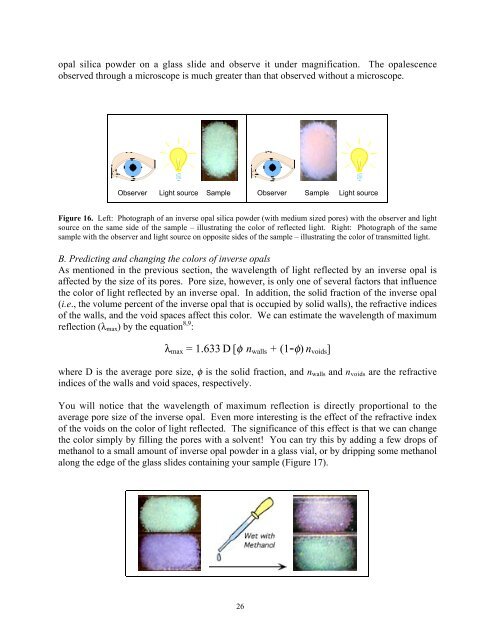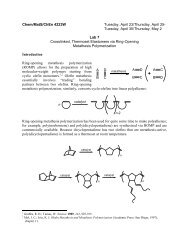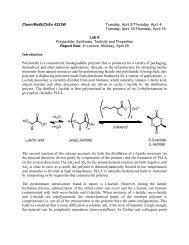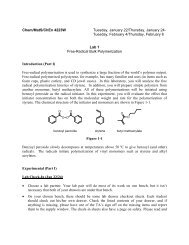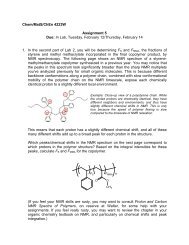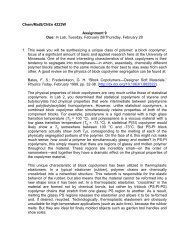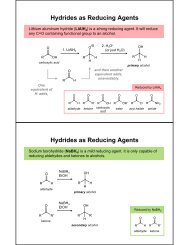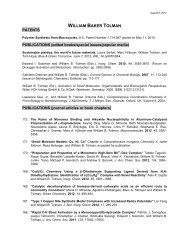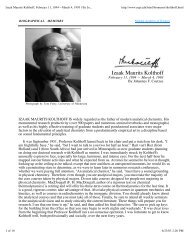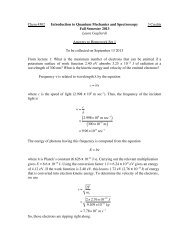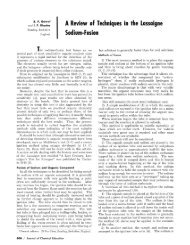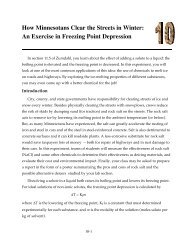Inverse Opal Photonic Crystals - Department of Chemistry ...
Inverse Opal Photonic Crystals - Department of Chemistry ...
Inverse Opal Photonic Crystals - Department of Chemistry ...
You also want an ePaper? Increase the reach of your titles
YUMPU automatically turns print PDFs into web optimized ePapers that Google loves.
opal silica powder on a glass slide and observe it under magnification. The opalescence<br />
observed through a microscope is much greater than that observed without a microscope.<br />
Observer Light source Sample Observer Sample Light source<br />
Figure 16. Left: Photograph <strong>of</strong> an inverse opal silica powder (with medium sized pores) with the observer and light<br />
source on the same side <strong>of</strong> the sample – illustrating the color <strong>of</strong> reflected light. Right: Photograph <strong>of</strong> the same<br />
sample with the observer and light source on opposite sides <strong>of</strong> the sample – illustrating the color <strong>of</strong> transmitted light.<br />
B. Predicting and changing the colors <strong>of</strong> inverse opals<br />
As mentioned in the previous section, the wavelength <strong>of</strong> light reflected by an inverse opal is<br />
affected by the size <strong>of</strong> its pores. Pore size, however, is only one <strong>of</strong> several factors that influence<br />
the color <strong>of</strong> light reflected by an inverse opal. In addition, the solid fraction <strong>of</strong> the inverse opal<br />
(i.e., the volume percent <strong>of</strong> the inverse opal that is occupied by solid walls), the refractive indices<br />
<strong>of</strong> the walls, and the void spaces affect this color. We can estimate the wavelength <strong>of</strong> maximum<br />
reflection (λ max ) by the equation 8,9 :<br />
λ max = 1.633 D [φ n walls + (1-φ) n voids ]<br />
where D is the average pore size, φ is the solid fraction, and n walls and n voids are the refractive<br />
indices <strong>of</strong> the walls and void spaces, respectively.<br />
You will notice that the wavelength <strong>of</strong> maximum reflection is directly proportional to the<br />
average pore size <strong>of</strong> the inverse opal. Even more interesting is the effect <strong>of</strong> the refractive index<br />
<strong>of</strong> the voids on the color <strong>of</strong> light reflected. The significance <strong>of</strong> this effect is that we can change<br />
the color simply by filling the pores with a solvent! You can try this by adding a few drops <strong>of</strong><br />
methanol to a small amount <strong>of</strong> inverse opal powder in a glass vial, or by dripping some methanol<br />
along the edge <strong>of</strong> the glass slides containing your sample (Figure 17).<br />
26


